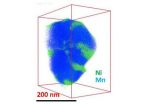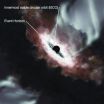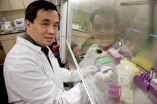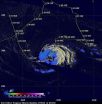(Press-News.org) Using a continent-spanning telescope, an international team of astronomers has peered to the edge of a black hole at the center of a distant galaxy. For the first time, they have measured the black hole's "point of no return" - the closest distance that matter can approach before being irretrievably pulled into the black hole.
A black hole is a region in space where the pull of gravity is so strong that nothing, not even light, can escape. Its boundary is known as the event horizon.
"Once objects fall through the event horizon, they're lost forever," says lead author Shep Doeleman, assistant director at the MIT Haystack Observatory and research associate at the Harvard-Smithsonian Center for Astrophysics (CfA). "It's an exit door from our universe. You walk through that door, you're not coming back."
The team examined the black hole at the center of a giant elliptical galaxy called Messier 87 (M87), which is located about 50 million light-years from Earth. That black hole is 6 billion times more massive than the Sun. It's surrounded by an accretion disk of gas swirling toward the black hole's maw. Although the black hole is invisible, the accretion disk is hot enough to glow.
"Even though this black hole is far away, it's so big that its apparent size on the sky is about the same as the black hole at the center of the Milky Way," says co-author Jonathan Weintroub of the CfA. "That makes it an ideal target for study."
According to Einstein's theory of general relativity, a black hole's mass and spin determine how close material can orbit before becoming unstable and falling in toward the event horizon. The team was able to measure this innermost stable orbit and found that it's only 5.5 times the size of the black hole's event horizon. This size suggests that the accretion disk is spinning in the same direction as the black hole.
The observations were made by linking together radio telescopes in Hawaii, Arizona and California to create a virtual telescope called the Event Horizon Telescope, or EHT. The EHT is capable of seeing details 2,000 times finer than the Hubble Space Telescope.
The team plans to expand its telescope array, adding radio dishes in Chile, Europe, Mexico, Greenland, and the South Pole, in order to obtain even more detailed pictures of black holes in the future.
### END
Peering to the edge of a black hole
2012-09-28
ELSE PRESS RELEASES FROM THIS DATE:
New fish species offers literal take on 'hooking up'
2012-09-28
Fishing hooks aren't the only hooks found in east-central Mexican waters.
A new species of freshwater fish described by a North Carolina State University researcher has several interesting – and perhaps cringe-inducing – characteristics, including a series of four hooks on the male genitalia.
Females of the new species – the llanos mosquitofish, or Gambusia quadruncus – also have distinguishing characteristics, including a colorful anal spot.
A paper describing the new species, which lives in a diversity hotspot and seemingly branched off from its closest relative ...
Deadly complication of stem cell transplants reduced in mice
2012-09-28
Studying leukemia in mice, researchers at Washington University School of Medicine in St. Louis have reduced a life-threatening complication of stem cell transplants, the only curative treatment when leukemia returns.
About 50 percent of leukemia patients who receive stem cells from another person develop graft-versus-host disease, a condition where donor immune cells attack the patient's own body. The main organs affected are the skin, liver and gut. Now, the scientists have shown they can redirect donor immune cells away from these vital organs. Steering immune cells ...
Nickelblock: An element's love-hate relationship with battery electrodes
2012-09-28
RICHLAND, Wash. -- Anyone who owns an electronic device knows that lithium ion batteries could work better and last longer. Now, scientists examining battery materials on the nano-scale reveal how nickel forms a physical barrier that impedes the shuttling of lithium ions in the electrode, reducing how fast the materials charge and discharge. Published last week in Nano Letters, the research also suggests a way to improve the materials.
The researchers, led by the Department of Energy's Pacific Northwest National Laboratory's Chongmin Wang, created high-resolution 3D ...
Measuring the universe's 'exit door'
2012-09-28
CAMBRIDGE, MA -- The point of no return: In astronomy, it's known as a black hole — a region in space where the pull of gravity is so strong that nothing, not even light, can escape. Black holes that can be billions of times more massive than our sun may reside at the heart of most galaxies. Such supermassive black holes are so powerful that activity at their boundaries can ripple throughout their host galaxies.
Now, an international team, led by researchers at MIT's Haystack Observatory, has for the first time measured the radius of a black hole at the center of a distant ...
World's first glimpse of a black hole 'launchpad'
2012-09-28
A strange thing about black holes: they shine.
The current issue of Science Express features a paper by the Event Horizon telescope team – a collaboration that includes Avery Broderick, Associate Faculty at Perimeter Institute – that may shed light on the origin of the bright jets given off by some black holes. In a world first, the team has been able to look at a distant black hole and find out where its jets are launched from: the "launchpad".
Many galaxies, including our own Milky Way, have a huge black hole lurking at their cores. In about 10 percent of such galaxies, ...
Newspaper sales suffer due to lack of stimulating content
2012-09-28
Los Angeles, CA (September 27, 2012) – Since the newspaper industry started to experience a major decrease in readership in recent years, many people have deemed the internet and other forms of new media as the culprits. However, a recent study published in the Journalism & Mass Communication Quarterly, a SAGE Journal, finds that sales are down because readers need more engaging and stimulating content.
Study authors Rachel Davis Mersey, Edward C. Malthouse, and Bobby J. Calder suggested that it is crucial for journalists and practitioners to focus their efforts on creating ...
Researchers investigate aggression among kindergartners
2012-09-28
UNIVERSITY PARK, Pa. -- Not all aggressive children are aggressive for the same reasons, according to Penn State researchers, who found that some kindergartners who are aggressive show low verbal abilities while others are more easily physiologically aroused. The findings suggest that different types of treatments may be needed to help kids with different underlying causes for problem behavior.
"Aggressive responses to being frustrated are a normal part of early childhood, but children are increasingly expected to manage their emotions and control their behavior when ...
Liver cells, insulin-producing cells, thymus can be grown in lymph nodes, Pitt team finds
2012-09-28
PITTSBURGH, Sept. 27, 2012 – Lymph nodes can provide a suitable home for a variety of cells and tissues from other organs, suggesting that a cell-based alternative to whole organ transplantation might one day be feasible, according to researchers at the University of Pittsburgh School of Medicine and its McGowan Institute for Regenerative Medicine. In a report recently published online in Nature Biotechnology, the research team showed for the first time that liver cells, thymus tissue and insulin-producing pancreatic islet cells, in an animal model, can thrive in lymph ...
Genetic sleuthing uncovers deadly new virus in Africa
2012-09-28
An isolated outbreak of a deadly disease known as acute hemorrhagic fever, which killed two people and left one gravely ill in the Democratic Republic of Congo in the summer of 2009, was probably caused by a novel virus scientists have never seen before.
Described this week in the open-access journal PLoS Pathogens, the new microbe has been named Bas-Congo virus (BASV) after the province in the southwest corner of the Congo where the three people lived.
It was discovered by an international research consortium that included the University of California, San Francisco ...
NASA sees light rainfall in Tropical Storm Nadine
2012-09-28
NASA's TRMM satellite noticed that the intensity of rainfall in Tropical Storm Nadine has diminished today, Sept. 27.
The Tropical Rainfall Measuring Mission or TRMM satellite passed over Tropical Storm Nadine on Sept. 27 at 0739 UTC (4:39 a.m. EDT) and at 0917 UTC (5:17 a.m. EDT). At NASA's Goddard Space Flight Center in Greenbelt, Md., several TRMM instruments were used to create a full picture of Nadine's weakened rainfall. The image was created with an enhanced infrared image from TRMM's Visible and InfraRed Scanner (VIRS) overlaid with rainfall data derived from ...




